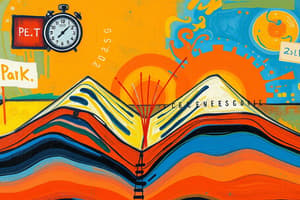Podcast
Questions and Answers
What type of wave is characterized by side-to-side movement of the ground?
What type of wave is characterized by side-to-side movement of the ground?
- Love Waves
- P Waves
- Rayleigh Waves
- S Waves (correct)
Which type of seismic wave travels more slowly and causes the most damage during an earthquake?
Which type of seismic wave travels more slowly and causes the most damage during an earthquake?
- P Waves
- S Waves
- Surface Waves (correct)
- Body Waves
What does the magnitude of an earthquake measure?
What does the magnitude of an earthquake measure?
- The total duration of the earthquake
- The distance the waves travel
- The intensity of shaking felt by people
- The energy released at the source (correct)
Which seismic wave is known for causing horizontal shearing of the ground?
Which seismic wave is known for causing horizontal shearing of the ground?
How does intensity differ from magnitude in measuring earthquakes?
How does intensity differ from magnitude in measuring earthquakes?
What type of stress occurs when forces pull apart?
What type of stress occurs when forces pull apart?
Which type of fault is characterized by the rock above the fracture plane moving downwards?
Which type of fault is characterized by the rock above the fracture plane moving downwards?
Which fault type occurs when rocks on the 'uphill' side of an inclined plane rise above the other side?
Which fault type occurs when rocks on the 'uphill' side of an inclined plane rise above the other side?
What is the term used for the sudden elastic rebound of previously stored energy in the context of earthquakes?
What is the term used for the sudden elastic rebound of previously stored energy in the context of earthquakes?
Where is the epicenter of an earthquake located?
Where is the epicenter of an earthquake located?
Which type of stress involves forces that slide past each other?
Which type of stress involves forces that slide past each other?
What defines a strike-slip fault?
What defines a strike-slip fault?
What happens at the focus of an earthquake?
What happens at the focus of an earthquake?
What is the main cause of tectonic earthquakes?
What is the main cause of tectonic earthquakes?
Which type of earthquake is responsible for 95% of all earthquakes?
Which type of earthquake is responsible for 95% of all earthquakes?
What are tremors primarily characterized by?
What are tremors primarily characterized by?
What term is used to describe earthquakes caused by human activities?
What term is used to describe earthquakes caused by human activities?
What drives the movement of tectonic plates?
What drives the movement of tectonic plates?
Which of the following descriptions best characterizes stress in geological terms?
Which of the following descriptions best characterizes stress in geological terms?
What commonly results from the movement of tectonic plates over time?
What commonly results from the movement of tectonic plates over time?
Volcanic earthquakes are typically caused by what process?
Volcanic earthquakes are typically caused by what process?
Flashcards are hidden until you start studying
Study Notes
Earthquake Causes
- Earthquakes are caused by the sudden release of energy in the Earth's crust.
- Tectonic earthquakes are the most common type, caused by the movement of tectonic plates.
- Volcanic earthquakes are associated with volcanic activity and are caused by magma movement.
- Man-made earthquakes, also known as induced seismicity, can occur due to human activities like mining and fluid extraction.
Earthquake Types
- Earthquakes are distinguished based on their origin and intensity.
- Tremors are milder seismic vibrations compared to earthquakes.
Tectonic Plates
- Tectonic plates are large pieces of the Earth's lithosphere, which consists of the upper mantle and crust.
- These plates move slowly across the semi-fluid asthenosphere due to convection currents, gravity, and Earth's rotation.
Plate Boundaries
- Tectonic plates meet at boundaries where they interact.
- Interactions at these boundaries are categorized based on how plates move:
- Divergent: Plates move apart.
- Convergent: Plates collide.
- Transform: Plates slide past each other.
Stress and Strain
- Stress: Force applied per unit area, causing deformation in rocks.
- Tensile Stress: Forces pull apart.
- Compressive Stress: Forces push together.
- Shear Stress: Forces slide past each other.
- Strain: Deformation resulting from applied stress.
- The gradual buildup and release of stress and strain is explained by the "elastic rebound theory."
Faults
- A fault is a fracture or zone of fractures in the Earth's crust where rock movement has occurred.
- The area directly above where two tectonic plates interact is called a fault.
Types of Faults
- Normal Fault: Rocks above an inclined fracture plane move downward.
- Reverse Fault: Rocks on the uphill side of an inclined fault plane move upward.
- Strike-Slip Fault: Blocks of rock move past each other horizontally.
Focus and Epicenter
- Focus: Point inside the Earth where an earthquake originates, releasing energy and creating seismic waves.
- Epicenter: Point on the Earth's surface directly above the focus.
Seismic Waves
- Seismic waves are energy waves that travel through the Earth due to an earthquake.
- Body Waves: travel through the Earth's interior.
- P (Primary) Waves: Compressional waves, push and pull the ground.
- S (Secondary) Waves: Shear waves, move the ground side-to-side.
- Surface Waves: travel along the Earth's surface.
- Love Waves: Cause horizontal shearing.
- Rayleigh Waves: Cause elliptical, rolling motion.
Earthquake Measurement
- Magnitude: Measures the energy released at the earthquake's source.
- Intensity: Measures the effects of an earthquake at specific locations, assessing shaking felt and damage.
Studying That Suits You
Use AI to generate personalized quizzes and flashcards to suit your learning preferences.




